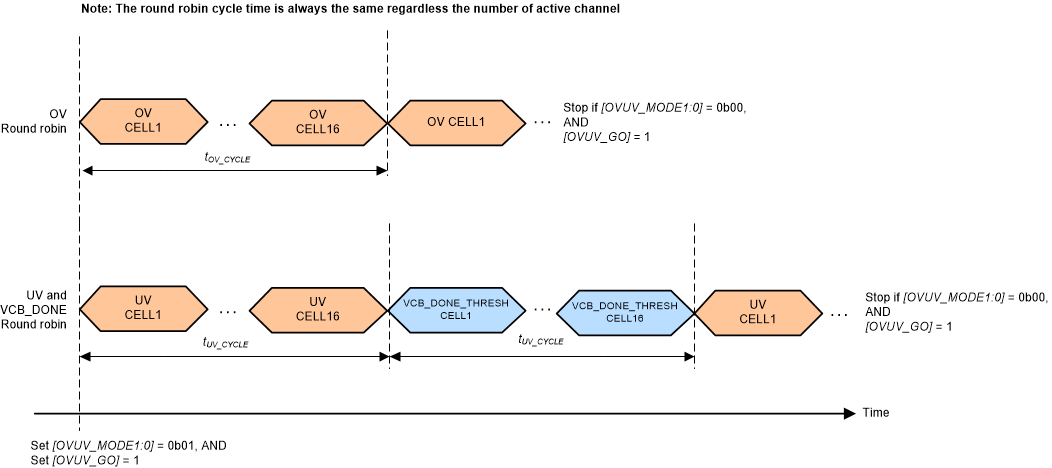JAJSRJ8B September 2019 – October 2023 BQ75614-Q1
PRODUCTION DATA
- 1
- 1 特長
- 2 アプリケーション
- 3 概要
- 4 Revision History
- 5 概要 (続き)
- 6 Pin Configuration and Functions
- 7 Specifications
-
8 Detailed Description
- 8.1 Overview
- 8.2 Functional Block Diagram
- 8.3
Feature Description
- 8.3.1 Power Supplies
- 8.3.2 Measurement System
- 8.3.3 Cell Balancing
- 8.3.4 Integrated Hardware Protectors
- 8.3.5 GPIO Configuration
- 8.3.6
Communication, OTP, Diagnostic Control
- 8.3.6.1 Communication
- 8.3.6.2 Fault Handling
- 8.3.6.3 Nonvolatile Memory
- 8.3.6.4 Diagnostic Control/Status
- 8.4 Device Functional Modes
- 8.5
Register Maps
- 8.5.1 OTP Shadow Register Summary
- 8.5.2 Read/Write Register Summary
- 8.5.3 Read-Only Register Summary
- 8.5.4
Register Field Descriptions
- 8.5.4.1 Device Addressing Setup
- 8.5.4.2 Device ID and Scratch Pad
- 8.5.4.3 General Configuration and Control
- 8.5.4.4 Operation Status
- 8.5.4.5 ADC Configuration and Control
- 8.5.4.6
ADC Measurement Results
- 8.5.4.6.1 VCELL16_HI/LO
- 8.5.4.6.2 VCELL15_HI/LO
- 8.5.4.6.3 VCELL14_HI/LO
- 8.5.4.6.4 VCELL13_HI/LO
- 8.5.4.6.5 VCELL12_HI/LO
- 8.5.4.6.6 VCELL11_HI/LO
- 8.5.4.6.7 VCELL10_HI/LO
- 8.5.4.6.8 VCELL9_HI/LO
- 8.5.4.6.9 VCELL8_HI/LO
- 8.5.4.6.10 VCELL7_HI/LO
- 8.5.4.6.11 VCELL6_HI/LO
- 8.5.4.6.12 VCELL5_HI/LO
- 8.5.4.6.13 VCELL4_HI/LO
- 8.5.4.6.14 VCELL3_HI/LO
- 8.5.4.6.15 VCELL2_HI/LO
- 8.5.4.6.16 VCELL1_HI/LO
- 8.5.4.6.17 MAIN_CURRENT_HI/LO
- 8.5.4.6.18 CURRENT_HI/MID/LO
- 8.5.4.6.19 TSREF_HI/LO
- 8.5.4.6.20 GPIO1_HI/LO
- 8.5.4.6.21 GPIO2_HI/LO
- 8.5.4.6.22 GPIO3_HI/LO
- 8.5.4.6.23 GPIO4_HI/LO
- 8.5.4.6.24 GPIO5_HI/LO
- 8.5.4.6.25 GPIO6_HI/LO
- 8.5.4.6.26 GPIO7_HI/LO
- 8.5.4.6.27 GPIO8_HI/LO
- 8.5.4.6.28 DIETEMP1_HI/LO
- 8.5.4.6.29 DIETEMP2_HI/LO
- 8.5.4.6.30 AUX_CELL_HI/LO
- 8.5.4.6.31 AUX_GPIO_HI/LO
- 8.5.4.6.32 AUX_BAT_HI/LO
- 8.5.4.6.33 AUX_REFL_HI/LO
- 8.5.4.6.34 AUX_VBG2_HI/LO
- 8.5.4.6.35 AUX_AVAO_REF_HI/LO
- 8.5.4.6.36 AUX_AVDD_REF_HI/LO
- 8.5.4.6.37 AUX_OV_DAC_HI/LO
- 8.5.4.6.38 AUX_UV_DAC_HI/LO
- 8.5.4.6.39 AUX_OT_OTCB_DAC_HI/LO
- 8.5.4.6.40 AUX_UT_DAC_HI/LO
- 8.5.4.6.41 AUX_VCBDONE_DAC_HI/LO
- 8.5.4.6.42 AUX_VCM_HI/LO
- 8.5.4.6.43 REFOVDAC_HI/LO
- 8.5.4.6.44 DIAG_MAIN_HI/LO
- 8.5.4.6.45 DIAG_AUX_HI/LO
- 8.5.4.7 Balancing Configuration, Control and Status
- 8.5.4.8 Protector Configuration and Control
- 8.5.4.9 GPIO Configuration
- 8.5.4.10 SPI Master
- 8.5.4.11 Diagnostic Control
- 8.5.4.12 Fault Configuration and Reset
- 8.5.4.13
Fault Status
- 8.5.4.13.1 FAULT_SUMMARY
- 8.5.4.13.2 FAULT_COMM1
- 8.5.4.13.3 FAULT_OTP
- 8.5.4.13.4 FAULT_SYS
- 8.5.4.13.5 FAULT_PROT1
- 8.5.4.13.6 FAULT_PROT2
- 8.5.4.13.7 FAULT_OV1
- 8.5.4.13.8 FAULT_OV2
- 8.5.4.13.9 FAULT_UV1
- 8.5.4.13.10 FAULT_UV2
- 8.5.4.13.11 FAULT_OT
- 8.5.4.13.12 FAULT_UT
- 8.5.4.13.13 FAULT_COMP_GPIO
- 8.5.4.13.14 FAULT_COMP_VCCB1
- 8.5.4.13.15 FAULT_COMP_VCCB2
- 8.5.4.13.16 FAULT_COMP_VCOW1
- 8.5.4.13.17 FAULT_COMP_VCOW2
- 8.5.4.13.18 FAULT_COMP_CBOW1
- 8.5.4.13.19 FAULT_COMP_CBOW2
- 8.5.4.13.20 FAULT_COMP_CBFET1
- 8.5.4.13.21 FAULT_COMP_CBFET2
- 8.5.4.13.22 FAULT_COMP_MISC
- 8.5.4.13.23 FAULT_PWR1
- 8.5.4.13.24 FAULT_PWR2
- 8.5.4.13.25 FAULT_PWR3
- 8.5.4.14 Debug Control and Status
- 8.5.4.15
OTP Programming Control and Status
- 8.5.4.15.1 OTP_PROG_UNLOCK1A through OTP_PROG_UNLOCK1D
- 8.5.4.15.2 OTP_PROG_UNLOCK2A through OTP_PROG_UNLOCK2D
- 8.5.4.15.3 OTP_PROG_CTRL
- 8.5.4.15.4 OTP_ECC_TEST
- 8.5.4.15.5 OTP_ECC_DATAIN1 through OTP_ECC_DATAIN9
- 8.5.4.15.6 OTP_ECC_DATAOUT1 through OTP_ECC_DATAOUT9
- 8.5.4.15.7 OTP_PROG_STAT
- 8.5.4.15.8 OTP_CUST1_STAT
- 8.5.4.15.9 OTP_CUST2_STAT
- 9 Application and Implementation
- 10Power Supply Recommendations
- 11Layout
- 12Device and Documentation Support
- 13Mechanical, Packaging, and Orderable Information
8.3.4.1.1 OVUV Operation Modes
The OV and UV protectors have several operation modes controlled by OVUV_CTRL[OVUV_MODE1:0] and is summarized in Table 8-7. To start the OVUV protectors, MCU sets OVUV_CTRL[OVUV_GO] = 1.
Table 8-7 OVUV Protector Operation Modes
| [OVUV_MOD1:0] | Operation Mode | Description |
|---|---|---|
| 0b00 | Stop OV and UV protectors | Stop OV and UV protectors |
| 0b01 | Round robin run | The OV and UV protectors are looping through all VC inputs. The active channels are checked against the OV and UV thresholds (Figure 8-19). The round robin cycle timing is always the same regardless of the number of the active channels. For the inactive VC channels, the digital logic simply ignores the detection outcome. The UV protector detects both UV_THRESH and VCB_DONE_THRESH. |
| 0b10 | OV and UV BIST run (diagnostic use, see Section 8.3.6.4 for details) | A BIST (built-in self-test) cycle on the OV and UV comparators and the detection paths. VCELL (VC channels) ADC measurement from the Main ADC and the OV and UV detections through the OVUV protectors are not available during this run. MCU shall stop ADC measurement when performing OVUV BIST. |
| 0b11 | Single channel run (diagnostic use, see Section 8.3.6.4 for details) | Use for checking the OV and UV DACs. The OV and UV comparator is locked to a single VC input channel in this mode. Channel is locked by OVUV_CTRL[OVUV_LOCK3:0]. |
If OVUV BIST run is in progress, but MCU start ADC, the ADC result registers will be held at 0x8000. ADC measurements will resume once OVUV BIST is completed and after tAFE_SETTLE time pass.
If ADC is running, but MCU start OVUV BIST, the ADC result registers will be held at its last measurement. ADC measurement update resumes once OVUV BIST is completed and after tAFE_SETTLE time pass
 Figure 8-20 OV and UV Round Robin Mode
Figure 8-20 OV and UV Round Robin Mode